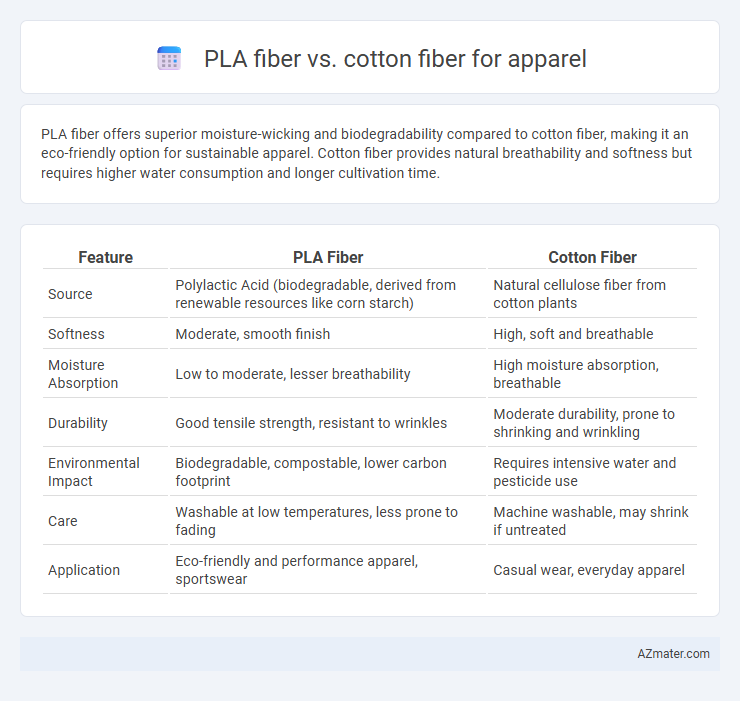PLA fiber offers superior moisture-wicking and biodegradability compared to cotton fiber, making it an eco-friendly option for sustainable apparel. Cotton fiber provides natural breathability and softness but requires higher water consumption and longer cultivation time.
Table of Comparison
| Feature | PLA Fiber | Cotton Fiber |
|---|---|---|
| Source | Polylactic Acid (biodegradable, derived from renewable resources like corn starch) | Natural cellulose fiber from cotton plants |
| Softness | Moderate, smooth finish | High, soft and breathable |
| Moisture Absorption | Low to moderate, lesser breathability | High moisture absorption, breathable |
| Durability | Good tensile strength, resistant to wrinkles | Moderate durability, prone to shrinking and wrinkling |
| Environmental Impact | Biodegradable, compostable, lower carbon footprint | Requires intensive water and pesticide use |
| Care | Washable at low temperatures, less prone to fading | Machine washable, may shrink if untreated |
| Application | Eco-friendly and performance apparel, sportswear | Casual wear, everyday apparel |
Introduction to PLA Fiber and Cotton Fiber
PLA fiber, derived from renewable resources such as corn starch or sugarcane, offers a sustainable alternative to traditional fibers with biodegradable properties and moisture-wicking capabilities. Cotton fiber, a natural cellulose fiber harvested from cotton plants, is known for its breathability, softness, and durability, making it a staple in apparel manufacturing. Both fibers have distinct environmental and performance characteristics, with PLA fiber emphasizing eco-friendliness and cotton fiber prioritizing comfort and natural feel.
Composition and Source Comparison
PLA fiber, derived from renewable resources like corn starch or sugarcane, is a biodegradable polyester offering lightweight and moisture-wicking properties ideal for activewear, while cotton fiber originates from the cotton plant, featuring natural breathability and softness preferred for comfort-focused apparel. The composition of PLA fiber involves polylactic acid polymers synthesized through fermentation, contrasting with cotton's cellulose-based structure composed of natural plant fibers. Sourcing PLA fiber promotes sustainability through agricultural feedstocks and lower environmental impact, whereas cotton cultivation demands significant water and pesticide use, influencing ecological footprints in apparel production.
Environmental Impact and Sustainability
PLA fiber, derived from renewable resources like corn starch, offers a lower carbon footprint and is biodegradable under industrial composting conditions, making it a more environmentally sustainable option compared to cotton. Cotton cultivation requires significant water, pesticides, and land, contributing to environmental degradation and resource depletion. The biodegradability of PLA fiber reduces landfill waste, while cotton's longer decomposition time and intensive agricultural inputs pose challenges for sustainable apparel production.
Biodegradability and End-of-Life Considerations
PLA fiber, derived from renewable resources like corn starch, offers superior biodegradability compared to traditional cotton fiber, breaking down more rapidly under industrial composting conditions within 1-3 months. Cotton fiber, though naturally biodegradable, decomposes slower due to its denser cellulose structure and often involves pesticide use during cultivation, impacting environmental sustainability. End-of-life options for PLA include composting and recycling, reducing landfill impact, whereas cotton may require additional soil conditions or mechanical processing to fully degrade, highlighting key differences in sustainable apparel lifecycle management.
Comfort and Wearability Factors
PLA fiber offers excellent moisture-wicking properties and breathability, making it highly comfortable for apparel in warm climates. Cotton fiber provides superior softness and natural thermal regulation, enhancing wearability for sensitive skin and everyday use. Both fibers deliver unique comfort benefits, with PLA excelling in quick-drying performance and cotton standing out for durability and feel.
Moisture Management and Breathability
PLA fiber exhibits superior moisture-wicking capabilities compared to cotton fiber, efficiently drawing sweat away from the skin to promote faster evaporation. Its porous structure enhances breathability, allowing better air circulation and maintaining cooler body temperature during wear. Cotton fiber, while soft and comfortable, tends to retain moisture longer, which can lead to slower drying times and reduced overall breathability in apparel applications.
Durability and Strength Analysis
PLA fiber exhibits higher tensile strength and better resistance to abrasion compared to cotton fiber, making it a more durable option for apparel subjected to frequent wear. Cotton fibers tend to weaken and break down faster under repeated stress and washing cycles, reducing garment longevity. Advanced PLA textiles maintain shape and integrity over time, enhancing durability and strength for activewear and performance clothing applications.
Dyeability and Aesthetic Qualities
PLA fiber offers excellent dyeability with vibrant, long-lasting colors due to its hydrophobic nature and high crystallinity, making it ideal for bright and innovative apparel designs. Cotton fiber provides a natural matte finish and soft texture favored for comfort, with good dye absorption for a wide range of hues, especially reactive and direct dyes. PLA fibers produce a smooth and crisp appearance enhancing modern aesthetics, whereas cotton fibers yield a breathable, classic look appealing for casual and traditional garments.
Cost and Market Availability
PLA fiber offers a cost-effective alternative to traditional cotton fiber, with production expenses generally lower due to its renewable sources and efficient manufacturing processes. Cotton fiber remains widely available in global markets, benefiting from established supply chains and extensive cultivation, though its price can fluctuate based on environmental factors and labor costs. PLA fiber is gaining market presence, particularly in sustainable and eco-friendly apparel segments, but cotton continues to dominate mainstream textile production due to its durability and consumer familiarity.
Future Trends in Apparel Manufacturing
PLA fiber offers enhanced sustainability with its biodegradable properties and lower carbon footprint compared to traditional cotton fiber, making it a focal point in future apparel manufacturing trends. Innovations in bio-based PLA fiber improve moisture-wicking and durability, addressing common drawbacks of cotton such as high water usage and pesticide impact. Increasing consumer demand for eco-friendly textiles drives investment in PLA fiber production technologies, signaling a shift towards more circular and regenerative fashion supply chains.

Infographic: PLA fiber vs Cotton fiber for Apparel
 azmater.com
azmater.com